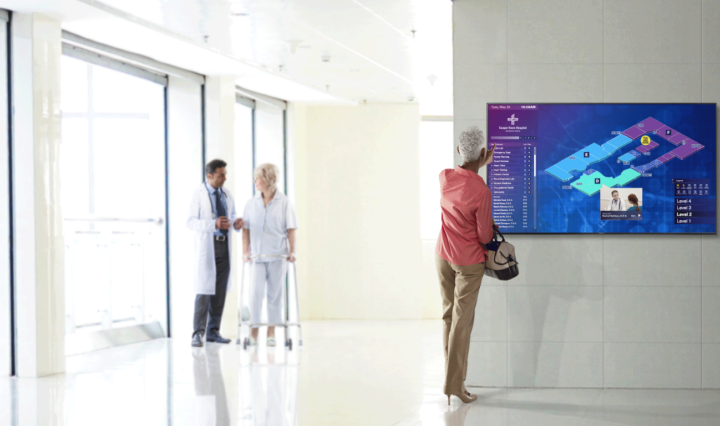Patient education isn’t a new priority for hospitals. Care teams work hard to get patients as healthy as possible, and want them to stay that way. But now that financial performance is closely tied to readmission rates and HCAHPS scores, it’s more important than ever to provide a satisfying patient experience that includes disease management education.
Many leading hospitals are now using digital technology to deliver interactive patient care and education. But simply putting the technology in place isn’t enough to ensure results — staff engagement is also critical to success.
AnMed Health — a five-hospital health system in South Carolina and Georgia — offers patients personalized disease management curricula using the TeleHealth SmarTigr patient engagement solution and Samsung healthcare TVs. To make the solution successful, AnMed Health has put strategies in place to build staff enthusiasm and make patient education an easy but integral part of nurses’ workflows.
How It Works
AnMed Health already had a Telehealth video education solution, but it was in need of an upgrade due to its operating system.
“With the old system, it wasn’t as easy for patients to pull videos up themselves,” explains Paula Martin, a registered nurse and organizational development consultant at AnMed Health. “And for nurses to find and assign relevant content, they had to go by video numbers, which was very time-consuming.”
AnMed Health upgraded to the SmarTigr platform in March 2014, allowing easier accessibility for patients and nurses. “Patients can now access the entire video library and other important hospital information from their TVs,” says Martin. “Nurses can easily assign videos by category to a patient’s ‘My To-Do List.’ This is much more user-friendly for our nurses, and they can build it into their routines.”
Hoping to improve their HCAHPS discharge information score, AnMed Health set a goal to increase video views by at least 25 percent. But the team quickly surpassed this goal and achieved an average of nearly 1,500 video views per month in 2015, up from 900 views per month in 2014. This amounted to a 67 percent average increase.
Within the first year of implementation, the TeleHealth/Samsung solution helped the organization boost HCAHPS discharge scores by 2.44 percent at AnMed Health Medical Center, and 1.35 percent at AnMed Health Women’s and Children’s Hospital. AnMed Health also increased the discharge information dimension of its value-based purchasing (VBP) by two full points in 2015, contributing to an increase in their VBP incentive points.
Creating the Hospital of the Future
See how healthcare leaders are using technology to revolutionize the patient journey. Download Now
Three Ways AnMed Health Makes Patient Education a Priority
To deliver interactive patient care and education, AnMed Health needed more than great technology. They needed staff to actually use it. Working closely with their TeleHealth account manager, Martin’s team has built a comprehensive awareness campaign to keep the solution top of mind for staff.
Here, Martin shares three secrets to their success:
1. Reinforce and communicate
The nursing staff receives hands-on training for the SmarTigr solution, but Martin says it’s also important to “constantly keep it in front of them.” To do so, her team sent weekly video spotlight emails that explain the value of featured videos and outline desired learning objectives.
AnMed Health also implemented “Tigr Tuesdays,” where the education team makes rounds to different nursing units to increase awareness, answer questions and educate staff on best practices. Martin explains, “We’re just going around and asking, ‘Have you assigned a video today? Will you assign one? If not, do you know how to use it? Let me show you now if you don’t.'”
2. Start small
Not wanting the patient education program to overwhelm staff, Martin and her team started by asking individuals to commit to assigning one condition-specific video per patient, per day.
“That’s why we far surpassed our goal,” says Martin. “Because I didn’t want to set a huge goal to begin with and make it too overwhelming where we didn’t succeed. Some nurses are still working on that initial goal, and others are assigning more.”
3. Recognize success
To keep staff engaged, AnMed Health publicizes which units are using the solution and how it’s positively affecting their HCAHPS discharge information scores. Units with the highest usage are featured in monthly emails. They also receive a blow-up tiger and a certificate recognizing their success.
“This helps create healthy competition,” says Martin. “Nobody wants the little tiger removed from their unit. And by linking usage to positive HCAHPS increases, we help them see why they’re doing it and what difference it’s making.”
AnMed Health is still working on new ways to boost video usage, and Martin sees even more room for improvement. But so far, the organization is happy with the results.
“I’d be lying if I said time wasn’t still a factor in us getting where we want to be,” she explains. “But our nurses are realizing it’s not as difficult or time-consuming as they thought, and that it allows them to educate patients when they’re not even in the room.”
To learn more about how digital technology helps hospitals engage patients, check out our interactive infographic.









